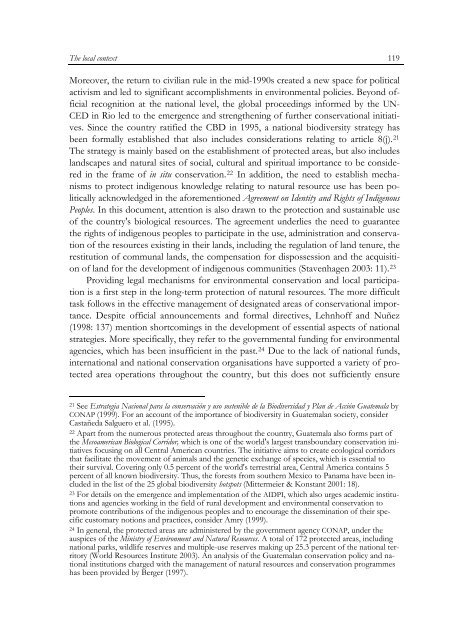The cultural context of biodiversity conservation - Oapen
The cultural context of biodiversity conservation - Oapen
The cultural context of biodiversity conservation - Oapen
You also want an ePaper? Increase the reach of your titles
YUMPU automatically turns print PDFs into web optimized ePapers that Google loves.
<strong>The</strong> local <strong>context</strong><br />
Moreover, the return to civilian rule in the mid-1990s created a new space for political<br />
activism and led to significant accomplishments in environmental policies. Beyond <strong>of</strong>ficial<br />
recognition at the national level, the global proceedings informed by the UN-<br />
CED in Rio led to the emergence and strengthening <strong>of</strong> further <strong>conservation</strong>al initiatives.<br />
Since the country ratified the CBD in 1995, a national <strong>biodiversity</strong> strategy has<br />
been formally established that also includes considerations relating to article 8(j). 21<br />
<strong>The</strong> strategy is mainly based on the establishment <strong>of</strong> protected areas, but also includes<br />
landscapes and natural sites <strong>of</strong> social, <strong>cultural</strong> and spiritual importance to be considered<br />
in the frame <strong>of</strong> in situ <strong>conservation</strong>. 22 In addition, the need to establish mechanisms<br />
to protect indigenous knowledge relating to natural resource use has been politically<br />
acknowledged in the aforementioned Agreement on Identity and Rights <strong>of</strong> Indigenous<br />
Peoples. In this document, attention is also drawn to the protection and sustainable use<br />
<strong>of</strong> the country's biological resources. <strong>The</strong> agreement underlies the need to guarantee<br />
the rights <strong>of</strong> indigenous peoples to participate in the use, administration and <strong>conservation</strong><br />
<strong>of</strong> the resources existing in their lands, including the regulation <strong>of</strong> land tenure, the<br />
restitution <strong>of</strong> communal lands, the compensation for dispossession and the acquisition<br />
<strong>of</strong> land for the development <strong>of</strong> indigenous communities (Stavenhagen 2003: 11). 23<br />
Providing legal mechanisms for environmental <strong>conservation</strong> and local participation<br />
is a first step in the long-term protection <strong>of</strong> natural resources. <strong>The</strong> more difficult<br />
task follows in the effective management <strong>of</strong> designated areas <strong>of</strong> <strong>conservation</strong>al importance.<br />
Despite <strong>of</strong>ficial announcements and formal directives, Lehnh<strong>of</strong>f and Nuñez<br />
(1998: 137) mention shortcomings in the development <strong>of</strong> essential aspects <strong>of</strong> national<br />
strategies. More specifically, they refer to the governmental funding for environmental<br />
agencies, which has been insufficient in the past. 24 Due to the lack <strong>of</strong> national funds,<br />
international and national <strong>conservation</strong> organisations have supported a variety <strong>of</strong> protected<br />
area operations throughout the country, but this does not sufficiently ensure<br />
21 See Estrategia Nacional para la conservación y uso sostenible de la Biodiversidad y Plan de Acción Guatemala by<br />
CONAP (1999). For an account <strong>of</strong> the importance <strong>of</strong> <strong>biodiversity</strong> in Guatemalan society, consider<br />
Castañeda Salguero et al. (1995).<br />
22 Apart from the numerous protected areas throughout the country, Guatemala also forms part <strong>of</strong><br />
the Mesoamerican Biological Corridor, which is one <strong>of</strong> the world's largest transboundary <strong>conservation</strong> initiatives<br />
focusing on all Central American countries. <strong>The</strong> initiative aims to create ecological corridors<br />
that facilitate the movement <strong>of</strong> animals and the genetic exchange <strong>of</strong> species, which is essential to<br />
their survival. Covering only 0.5 percent <strong>of</strong> the world's terrestrial area, Central America contains 5<br />
percent <strong>of</strong> all known <strong>biodiversity</strong>. Thus, the forests from southern Mexico to Panama have been included<br />
in the list <strong>of</strong> the 25 global <strong>biodiversity</strong> hotspots (Mittermeier & Konstant 2001: 18).<br />
23 For details on the emergence and implementation <strong>of</strong> the AIDPI, which also urges academic institutions<br />
and agencies working in the field <strong>of</strong> rural development and environmental <strong>conservation</strong> to<br />
promote contributions <strong>of</strong> the indigenous peoples and to encourage the dissemination <strong>of</strong> their specific<br />
customary notions and practices, consider Amry (1999).<br />
24 In general, the protected areas are administered by the government agency CONAP, under the<br />
auspices <strong>of</strong> the Ministry <strong>of</strong> Environment and Natural Resources. A total <strong>of</strong> 172 protected areas, including<br />
national parks, wildlife reserves and multiple-use reserves making up 25.3 percent <strong>of</strong> the national territory<br />
(World Resources Institute 2003). An analysis <strong>of</strong> the Guatemalan <strong>conservation</strong> policy and national<br />
institutions charged with the management <strong>of</strong> natural resources and <strong>conservation</strong> programmes<br />
has been provided by Berger (1997).<br />
119

















